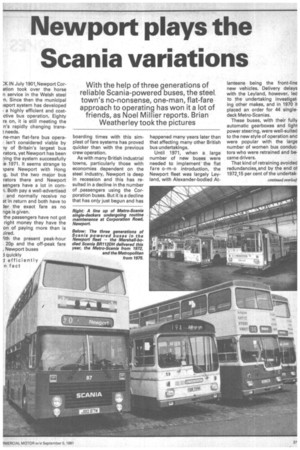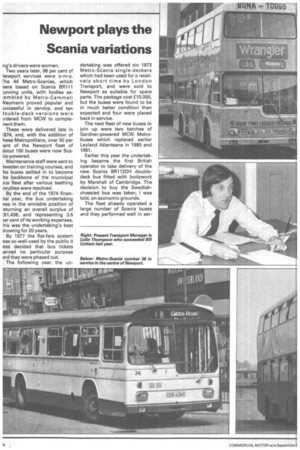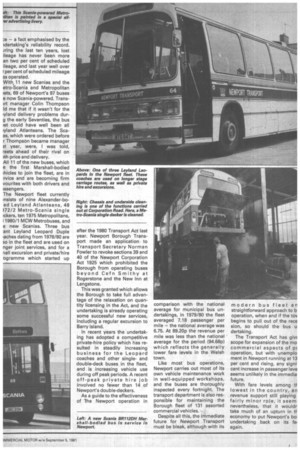Newport plays the Scania variations
Page 27

Page 28

Page 29

If you've noticed an error in this article please click here to report it so we can fix it.
With the help of three generations of reliable Scania-powered buses, the steel, town's no-nonsense, one-man, flat-fare approach to operating has won it a lot of friends, as Noel Millier reports. Brian Weatherley took the pictures
3K IN July 1901,Newport Coration took over the horse n service in the Welsh steel 'n. Since then the municipal 'sport system has developed 1 a highly efficient and costctive bus operation. Eighty rs on, it is still meeting the rapidly changing transneeds.
ne-man flat-fare bus operaI isn't considered viable by ly of Britain's largest bus rators, yet Newport has been fling the system successfully :e 1971. It seems strange to ipare Newport with Hong ig, but the two major bus rators there and Newport sengers have a lot in coml. Both pay a well-advertised and normally receive no at in return and both have to ier the exact fare as no nge is given.
the passengers have not got right money they have the on of paying more than is .ii red.
11th the present peak-hour 20p and the off-peak fare , Newport buses quickly d efficiently n fact boarding times with this simplest of fare systems has proved quicker than with the previous crew operation.
As with many British industrial towns, particularly those with economies dependent on the steel industry, Newport is deep in recession and this has resulted in a decline in the number of passengers using the Corporation buses. But it is a decline that has only just begun and has happened many years later than that affecting many other British bus undertakings.
Until 1971, when a large number of new buses were needed to implement the flat fare o-m-o introduction, the Newport fleet was largely Leyland, with Alexander-bodied At
lanteans being the front-line new vehicles. Delivery delays with the Leyland, however, led to the undertaking investigat, ing other makes, and in 1970 i1 placed an order for 44 singledeck Metro-Scanias.
These buses, with their fully automatic gearboxes and light power steering, were well-suited to the new style of operation and were popular with the large number of women bus conductors who were retrained and became drivers.
That kind of retraining avoided redundancies, and by the end o1 1972,15 per cent of the undertak ng's drivers were women.
Two years later, 98 per cent of 4ewport services were o-m-o. Ehe 44 Metro-Scanias, which vere based on Scania BR111 unning units, with bodies as;em bled by Metro-Cammell Neymann proved popular and ;uccessful in service, and ten iouble-deck versions were gdered from MCW to complenent them.
These were delivered late in 1974, and, with the addition of hese Metropolitans, over 50 per :ent of the Newport fleet of 'bout 100 buses were now Scalia-powered.
Maintenance staff were sent to 3weden on training courses, and he buses settled in to become he backbone of the municipal )us fleet after various teething roubles were resolved.
By the end of the 1974 finan;jai year, the bus undertaking vas in the enviable position of eturning an overall surplus of :61,438, and representing 3.6 )er cent of its working expenses, his was the undertaking's best ;howing for 20 years.
By 1977 the flat-fare system vas so well-used by the public it as decided that bus tickets ;erved no particular purpose 3nd they were phased out.
The following year, the un
dertaking was offered six 1973 Metro-Scania single-deckers which had been used for a relatively short time by London Transport, and were sold to Newport as suitable for spare parts. The package cost £10,000, but the buses were found to be in much better condition than expected and four were placed back in service.
The next fleet of new buses to join up were two batches of Gardner-powered MCW Metrobuses which replaced earlier Leyland Atlanteans in 1980 and 1981.
Earlier this year the undertaking became the first British operator to take delivery of the new Scania BR112DH doubledeck bus fitted with bodywork by Marshall of Cambridge. The decision to buy the Swedishchassied bus was taken, I was told, on economic grounds.
The fleet already operated a large number of Scania buses and they performed well in ser — a fact emphasised by the idertaking's reliability record. iring the last ten years, lost ileage has never been more an two per cent of scheduled ileage, and last year well over I per cent of scheduled mileage as operated.
With, 11 new Scanias and the etro-Scania and Metropolitan ,ets, 69 of Newport's 97 buses e now Scania-powered. Trans)rt manager Colin Thompson Id me that if it wasn't for the lyland delivery problems durg the early Seventies, the bus et could have well been all :yland Atlanteans. The Scaas, which were ordered before r Thompson became manager st year, were, I was told, reets ahead of their rival on )th price and delivery.
All 11 of the new buses, which e the first Marshall-bodied ihicles to join the fleet, are in !rvice and are becoming firm vourites with both drivers and Issengers.
The Newport fleet currently insists of nine Alexander-boed Leyland Atlanteans, 48 )72/2 Metro-Scania single )ckers, ten 1975 Metropolitans, 1980/1 MCW Metrobuses, and e new Scanias. Three bus ant Leyland Leopard Duple 'aches dating from 1978/80 are so in the fleet and are used on nger joint services, and for a nail excursion and private/hire °gramme which started up after the 1980 Transport Act last year. Newport Borough Transport made an application to Transport Secretary Norman Fowler to revoke sections 39 and 40 of the Newport Corporation Act 1925 which prohibited the Borough from operating buses beyond Cefn Smithy at Rogerstone and the New Inn at Langstone.
This was granted which allows the Borough to take full advantage of the relaxation on quantity licensing in the Act, and the undertaking is already operating some successful new services, including a regular excursion to Barry Island.
In recent years the undertaking has adopted a competitive private-hire policy which has resulted in steadily increasing business for the Leopard coaches and other singleand double-deck buses in the fleet, and is increasing vehicle use during off peak periods. A recent off-peak private hire job involved no fewer than 14 of Newport's double-deckers.
As a guide to the effectiveness of The Newport operation in comparison with the national average for municipal bus undertakings, in 1979/80 the fleet averaged 7.18 passenger per mile — the national average was 6.75. At 89.20p the revenue per mile was less than the national average for the period (94.68p) which reflects the generally lower fare levels in the Welsh town.
Like most bus operations, Newport carries out most of its own vehicle maintenance work in well-equipped workshops, and the buses are thoroughly inspected every fortnight. The transport department is also responsible for maintaining the Borough fleet of 131 assorted commercial vehicles.
Despite all this, the immediate future for Newport Transport must be bleak, although with its modern bus fleet an straightforward approach to b operation, when and if the toy begins to pull out of the rece sion, so should the bus u dertaking.
The Transport Act has giv( scope for expansion of the mo commercial aspects of pf. operation, but with unemplo ment in Newport running at 13 per cent and rising, any signi. cant increase in passenger leve seems unlikely in the immedia future.
With fare levels among th lowest in the country, an revenue support still playing fairly minor role, it seem: nevertheless, that it wouldr take much of an upturn in tleconomy to put Newport's bol undertaking back on its fel again.








































